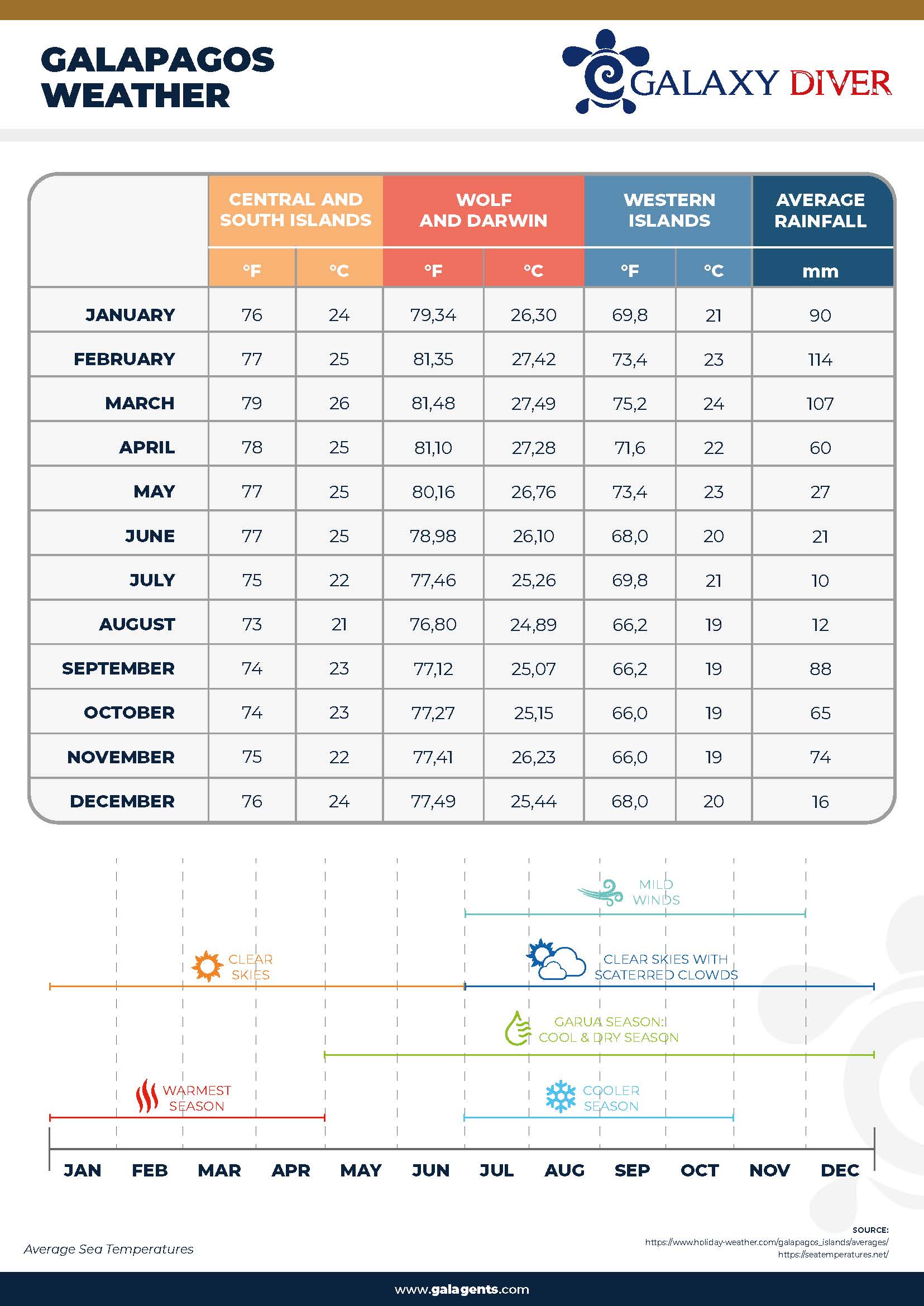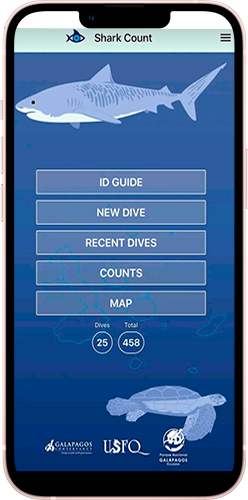GALAPAGOS
DIVING INFORMATION
GALAPAGOS INTRODUCTION
The Galapagos archipelago is located at a point where major ocean currents come together, mingling nutrient rich cool waters from the south, warm currents from the north, and a deep cold current from the west. This convergence of ocean currents has combined flora and fauna from contrasting environments, and given rise to unique marine species. Nearly 20% of marine life in Galapagos is endemic, found nowhere else on earth. This level of endemism is rare for marine species, which tend to migrate and intermingle to a much larger degree than terrestrial (land-based) species. The Galapagos Islands are home to the world’ s only marine iguana and the most northern-living penguin. Coral beds share the same waters as fur seals.
Galapagos is one of the only places where pelagic species — species that live neither close to the bottom of the ocean nor near the shore — can be seen close to shore, such as tunas, spotted eagle rays, golden rays, and hammerhead sharks. No other site in the world showcases such a diversity of marine life forms. Additionally, geological and biological processes in Galapagos have helped create a high variety of habitats relative to other marine areas in the eastern Pacific. Coastal areas include vertical cliffs, sandy beaches, rocky shores, mangroves, coral reefs, lagoons, and salt flats (hypersaline panne habitats).
SEA CONDITIONS AND WEATHER IN THE GALAPAGOS ISLANDS
WATER TEMPERATURE CONSIDERATIONS
- Water temperatures fluctuate through the year.
- Water temperatures are typically warmer in the northern islands at Wolf and Darwin and cooler in the western, southern and central islands of Galápagos.
- Thermoclines are common. Divers should be prepared for the water temps listed for all water temps: Western, Southern & Central AND Wolf & Darwin.
Temperature during the year
- December – May: The water is warmer, clearer 65-80°F, 18-27°C
- June – November: The water is cooler, 60-77°F, 15-25°C.
Weather in Galapagos
- Dec-May is our warm season with more sunshine and higher temps.
- Feb and March are the hottest months.
- June – Nov is the cooler season. Garua, a light mist, is often present, creating overcast days. Winds can create choppier seas.
GALAPAGOS TEMPERATURE AND RAINFALL

GET TO KNOW OUR RATES TO RENT THE DIVING GEAR
The person who rents the equipment is responsible for any loss or damage to the rented equipment while in his/her possession and agrees to return it in the same condition as received. All rental gear must be rinsed with fresh water and properly cleaned before it is returned. In case of damages, the renter will have to cover its expenses
RENTAL GEAR (Net prices per person)
| GEAR | 7 NIGHTS CRUISE |
| BCD | $75,00 |
| BOOTS & HOODS | $80,00 |
| DIVE COMPUTER | $70,00 |
| FINS | $30,00 |
| SNORKELING EQUIP. | $20,00 |
| REGULATOR WITH OCTOPUS AND CONSOLE | $75,00 |
| WETSUIT 7mm (full length) | $70,00 |
| 15L Aluminum Tank | $80,00 |
| MASK (frameless) | $25,00 |
| GLOVE 1.5 mm Tropic (only for sale) | $5,00 |
| FULL DIVE KIT | $275,00 |
| NITROX Course | $250,00 |
REPLACEMENT COSTS FOR DAMAGE OR LOSS OF PROVIDED OR RENTED EQUIPMENT:
| Dive Alert or SMB | $50 USD replacement cost |
| Nautilus Lifeline | $250 USD replacement cost |
| Nitrox Analyzer or Computer | $350 USD replacement cost |
| Weight Belt with weight (non emergency loss) | $75 USD replacement cost |
| Mask | $100 USD replacement cost |
| Fins | $100 USD replacement cost |
| Booties | $50 USD replacement cost |
| Wetsuit, BC, Regulator, Hoses | $50 - $750 USD replacement cost |
Notes: Full dive kit includes BCD, regulators, wetsuit, mask, booties, hoods and fins only.
Net price per person and must be requested prior arrival in order to guarantee service
FREQUENT QUESTIONS
What is the minimun age for divers in the Galaxy diver?
Whats the dive insurance needed?
We usually recommend contacting DAN or Dive Assure who can set you up with a travel insurance plan which includes general travel insurance, including trip cancellation …. plus full dive coverage.
Can beginners dive in the Galapagos?
How difficult is diving in Galapagos?
What experience is needed for diving in the Galapagos?
How many logged dives do you need at least to dive in the Galaxy Diver Galapagos?
What is the best time to go to the Galapagos?
From June to November, the water temperature decreases, providing an opportunity for cold-water diving. During this period, unique species such as hammerheads and whale sharks can be encountered. These months create a paradise for diving enthusiasts and marine life lovers.
What is the coldest month in Galapagos?
How is diving visibility in Galapagos?
Visibility is very dependent on the amount of plankton in the water. For this reason, the colder months of the year have poorer visibility than the warmer months. In exchange, more plankton in the water means more activity.
What gear do diving liveaboards usually have?
What is the best way to dive here?
Do the liveaboards rent equipment, or should I take my own?
Does Galapagos have a recompression chamber?
As a single traveler, must I pay a single supplement?
What languages are spoken?
What currency is used in Galapagos?
What is included in a Galapagos Diving trip?
Where do our Galapagos Diving trips starts?
What about flying after diving ?
What are the safety standards?
Which are the safety systems you use on the Galaxy Diver ?
For your consideration we are equipped with : DAN oxygen system , First Aid Equipment , 2 Tenders at your service and Life Jackets
Your diving package includes : Surfer Marker Buoy , nautilus Lifeline for each travelers , Dive alert with standar air couplings
Is Nitrox available?
What are the meals like aboard the Galaxy Diver?
Is the Internet available on the yacht?
Can I dive on my own?
Rebreather divers?
Decompression dives or technical diving?
What is the wetsuit needed for my trip?
Can I use a dry suit?
Can non divers accompany me on a dive trip?
What services will be available in my cabin?
Is there a Laundry service aboard?
What is the ratio of divers for dive guides?
What are the cylinder sizes ?
We have a limited number of 10 Litre steel, 13 Litre aluminium (100 cuft) and 15 Litre steel cylinders available for an additional charge, which must be pre-ordered.
All cylinders have convertible valves which can fit either Yoke (INT) or DIN regulators.



